Art & Exhibitions
What Went Wrong at the Liverpool Biennial?
Sometimes, cool locations just aren't enough.
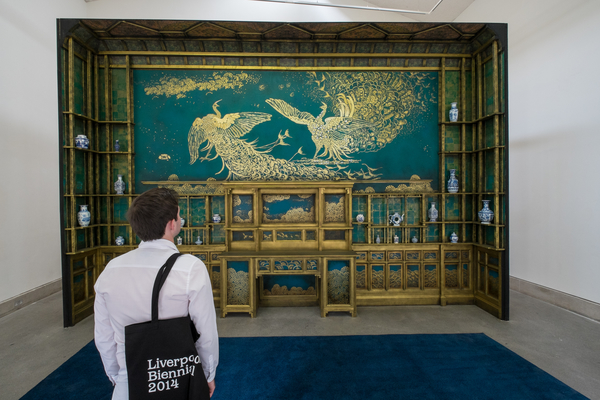
Sometimes, cool locations just aren't enough.

Coline Milliard

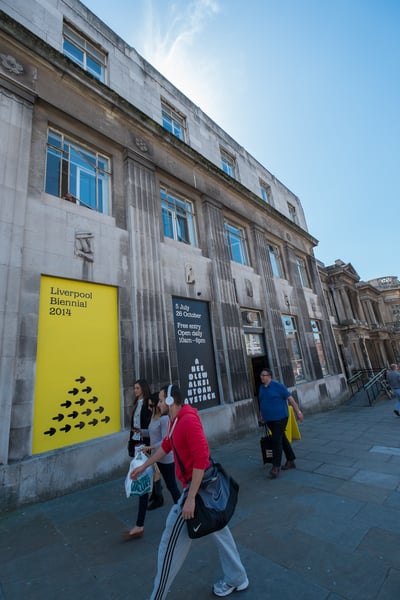
Liverpool Biennial 2014, A Needle Walks Into A Haystack, Group Show
The Old Blind School
Photo: © Mark McNulty
It comes with the assertive tagline “The UK Biennial of Contemporary Art,” positioning itself as Britain’s answer to Venice, or São Paulo. And over its 15 years of existence, the Liverpool Biennial has produced some remarkable moments. I particularly remember stumbling across a daringly bizarre presentation of Ryan Trecartin‘s films in 2010. Few people in the UK had heard of the Californian oddball back then. The encounter was electrifying.
There are some great moments in this eighth edition, entitled A Needle Walks into a Haystack, but I doubt they’ll leave such a lasting memory. This is all the more frustrating as curators Mai Abu ElDahab and Anthony Huberman have gathered all the ingredients for a solid show. Rather than quixotically trying to embrace countless practices, they’ve chosen to work with a reduced number of artists—25 of them in all—allowing for a fuller presentation of each. The heart of the exhibition is at the atmospheric Old Blind School, a neoclassical building that once served as Merseyside Police’s HQ, and later (somewhat ironically) the Trades Union Centre. The curators have cultivated the unexpected with a James McNeill Whistler exhibition at The Bluecoat, and given another artist, Sharon Lockhart, free reign to impress with a solo exhibition at FACT. Tate has also dug out some real treasures over at the Albert Dock. Yet, overall, A Needle Walks into a Haystack falls flat.
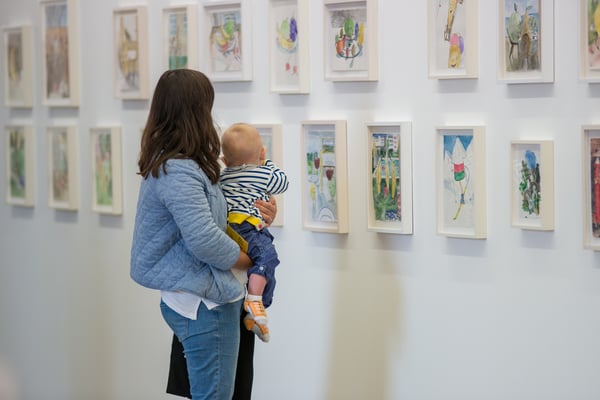
Liverpool Biennial 2014, A Needle Walks Into A Haystack, Group Show
The Old Blind School, installation view (Amelie von Wulffen)
Photo: © Mark McNulty
Why? After all, the charm of many biennials lies in the unusual venues they manage to unlock. Think of Maurizio Cattelan, Massimiliano Gioni and Ali Subotnick’s acclaimed 2006 Berlin Biennial at the old Jewish Girls’ School. Or the short-lived Dublin Contemporary, co-curated in 2011 by artnet’s very own Christian Viveros-Fauné at Earlsfort Terrace, the eerie former home of University College Dublin. Liverpool’s Old Blind School, with its elegantly peeling walls and endless corridors, ticks all the boxes. What it lacks, by and large, is content strong enough to carve a space for itself within such loaded architecture. Too much baffles. Chris Evans commissioned a local jeweler to create something based on the biennial’s press release; the result is a piece of conceptual kitsch, a ring as shiny as it is obtuse. Amelie von Wulffen‘s series of illustrations featuring objects engaged in various activities—fruit playing drinking games, a brush teaching smaller brushes about the different kinds of brushstrokes, mushrooms fucking—seem to have escaped the cartoon pages of a weekend magazine only by accident. Marc Bauer‘s realistic drawings executed in what the literature describes as a “dingy hotel” in Liverpool, appear, for most part, pointlessly self-absorbed—less Journey Around My Room and more teenage angst. But the most otiose artwork on display is Bonnie Camplin’s installation inviting visitors to experience her technique for “Deeper Observation of Small Objects.” This, in effect, is a confined room in which viewers are invited to look at an item of their choice, after being submitted to a dizzying light show. There is much pleasure to be had in the discovery, or the re-discovery, of everyday objects. I’m not sure that Camplin’s “magnification technology” and its “ultra-specific protocol” help tease out any of it. Instead, the eye wanders towards the ceiling rose, and its socialist realist fresco—a snapshot of history, movingly derelict.
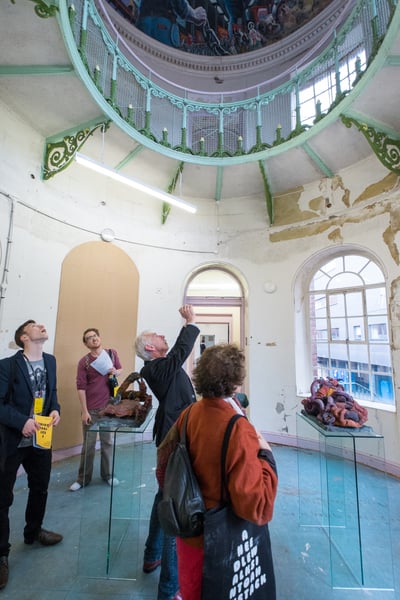
Visitors photographing the ceiling rose
Liverpool Biennial 2014, The Old Blind School
Photo: © Mark McNulty
A few genuine nuggets manage to claw the attention back. Judith Hopf’s subtle interventions—ropes raising from the floor as if hypnotized by a snake charmer, bronze branches sprouting from the walls, sheep made out of concrete blocks—combine a mischievous take on mundane objects with real sculptural concerns around the occupation of space and the emotional charge of certain materials. William Leavitt‘s retro-futurist paintings and installations offer a facetious take on modernism and the utopias that came with it. Chicago Imagist Christina Ramberg‘s drawings and paintings of garments oscillate dangerously, fascinatingly, between underwear and bondage accessories. In the acrylic on board Bagged (1968), a woman’s face is entirely covered by a eyeless mask, or a bag—perhaps suffocating, perhaps working to enhance the beauty of its faceless wearer. These feel as poignantly topical today as they must have done when they were created, surfing the crest of second wave feminism.
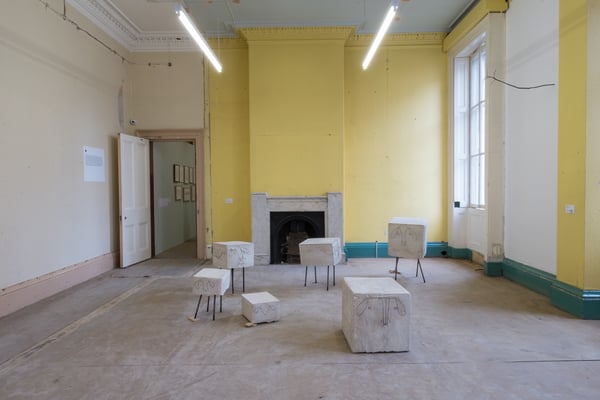
Liverpool Biennial 2014, A Needle Walks Into A Haystack, Group Show (Judith Hopf)
The Old Blind School
Photo: © Mark McNulty
But then, Whistler. It has become fashionable of late to give major contemporary art shows historical grounding. Carolyn Christov-Bakargiev put ancient Bactrian princesses in her exhibition’s “brain” at the last Documenta. Eyebrows were barely raised in Venice when Bice Curiger included two magnificent Tintorettos in the Central Pavilion or when Massimiliano Gioni stuffed the Arsenale with bits and bobs spanning centuries for his Encyclopedic Palace last year. The trend can only be applauded. Contemporary art has for too long presented itself as born solely of its time (perpetually reliving avant-garde delusion). Yet while a standard, scholarly Whistler show wouldn’t necessarily have been appropriate, the show gathers material that can only be described as anecdotal, and is by no means more successful. We learn much about his fierce character, his “white plume of hair,” as well as the conceptual and practical apparatus he devised to enhance the display of his pictures. But there’s hardly a painting in sight, only a few minor watercolors, a series of etchings, and the fabric canopy he used to diffuse daylight.

Liverpool Biennial 2014, James McNeill Whistler
The Bluecoat, installation view (The Peacock Room)
Photo: © Mark McNulty
The show climaxes with the Peacock Room Whistler designed for his Liverpool patron Frederick Leyland (the artist’s most obvious link to the city). The shipping magnate had only asked the artist to “harmonize” a dining room whose centerpiece was to be Whistler’s Asian-inspired painting Rose and Silver: The Princess from the Land of Porcelain (1865). But the painter went wild, daubing the ensemble in bold gold and turquoise hues, and, after Leyland started to argue over costs, adorning it with a caricature of himself and his patron as two fighting peacocks. The original Peacock Room is now kept at the Smithsonian in Washington DC, The Bluecoat’s exhibit a reconstruction executed by a local stage designer. It is articulated around the missing centerpiece—the same can be said for the show as a whole. Whistler’s staggeringly modern understanding of color composition, which paved the way for abstraction, is never really discussed. Instead, the show gives full attention to apocryphal details, which, while entertaining, distract from Whistler’s main contribution to art history. A single painting would have been more eloquent than this collection of memorabilia.
That’s not the case at Tate Liverpool. The showcase of 91-year-old French architect’s Claude Parent hits the core of his famous fonction oblique, a principle he devised with Paul Virilio as a critique of architecture’s pervasive orthogonalilty. His skateboard park-like slopes and ramps take viewers on a very idiosyncratic tour of some of the Tate collection’s highlights, from Francis Picabia‘s perennially intriguing Fig-Leaf painting from 1922, to Roy Lichtenstein‘s literally shimmery Moonscape (1985), via Naum Gabo and Blinky Palermo. The tension between an intensely constraining spatial intervention and the much more random selection of pieces, mainly selected, it seems, for their historical quality and poetic potential, makes the display the biennial’s most successful.